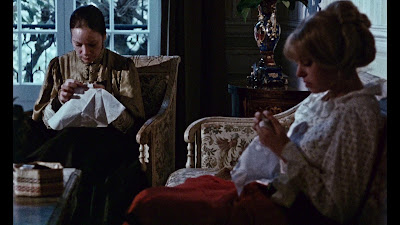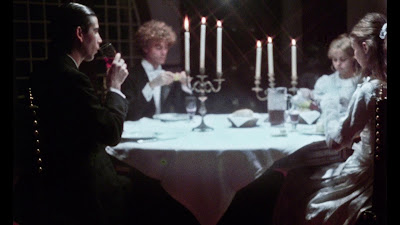Before I say anything about the film itself, grateful thanks must be extended once again to David Gregory's Severin Films for its continued support of Jess Franco's film legacy. In this case, said support extends to paying for the 4K restoration of the only known surviving print of one of his more obscure titles (reportedly donated by the Instituto de la Sexualidad Humana in Madrid); mind you, this is a film never before released in America and known to circulate before now primarily as an Italian-language bootleg. Such a release is nothing short of heroic, as counter-commercial as the film itself, and therefore fully deserving of our custom. What makes the gesture still more appreciable is that the film in question is so very odd, even within its niche; it's the only period film Franco shot in the seven-year spread between JACK THE RIPPER (1976) and El Hundimiento de la Casa Usher (1983), and his penultimate Sade adaptation, followed by THE SEXUAL STORY OF O in 1983-84.
Shot in Sintra, the magical area of Lisbon where A VIRGIN AMONG THE LIVING DEAD (1971) was filmed, this is a very personal, very cheap, yet remarkably sustained period adaptation of the Marquis de Sade. It's more akin to the Jean Epstein and Ivan Barnett adaptations of Poe than anyone could have expected from a 1980s feature, and also Franco's only attempt after 1968's JUSTINE to film Sade in an other than contemporary setting. It's based on the "Marquis de Bressac" portion of the novel JUSTINE, involving the characters more decorously portrayed by Horst Frank and Sylva Koscina in JUSTINE.
Inhabiting these roles in this telling are Armando Sallent as the Marquis de Bressac, an unrepentant sadist and sexual anarchist who has taken a gay lover (Mel Rodrigo) in the wake of his wife's placement in a mental sanatorium, a deed he has arranged by blackmailing a corrupt doctor (Albino Graziani) - named Louÿs in honor of the French erotic poet. The discharging of the wife, Martine (Lina Romay, in her blonde-wigged "Candice Coster" persona), prompts the two male lovers to contrive a plan to murder her for her vast fortune, but their plot unexpectedly coincides with the discovery of a violated novice nun (Susan Hemingway of LOVE LETTERS OF A PORTUGUESE NUN) on their castle grounds. The pleasure of corrupting the nun (in which Martine hungrily takes part) unexpectedly exposes the captive's nascent sadistic personality, and the subsequent revels ultimately prove punishing to all... as well as liberating to some.
The film is scored with excerpts from "Concerto No. 4" by Franz Liszt (a composer whose "Liesbestraum" figures in other Franco films, notably 1968's SUCCUBUS) and stabby washes of glacial electronic keyboard by Franco himself. Musically, the film is unusual though not entirely unfamiliar as Franco's work. However, it was shot (evidently in 16mm) in a fractured style and general vagueness that - Romay's surreptitious but transparent involvement aside - doesn't fully evoke the involvement of its director. Its use of Victorian dresses and hats, its shots of gay men gamboling in nature over canned classical music sometimes brings the work of Andy Milligan to mind; while, on the other end of the spectrum, Franco sometimes appears to be deliberately emulating (if not satirizing) the technique of Walerian Borowczyk, sharing his attention to period clothing, to rooms and furnishings, to antiquity, and indeed the eccentric off-kilter framing that we so often find in Borowcyk's work. Only in the film's subject matter and its numerous sideways glances into abstraction and lens-flexing is Franco's hand apparent. It's interesting that Franco would attempt something so unlike his usual self (no self-references, no humor), particularly at the same time Romay was going so far as to deny her own screen persona, and that these attempts to forge new creative identities would coincide with their return to Madrid after decades of self-exile.
It should also be noted that (depending on exactly when it was made) the film may have represented an under-the-radar reunion for the couple, who had gone their separate ways around 1976-77, at least onscreen - with Romay making films with other directors (Erwin C. Dietrich, Carlos Aured and Jorge Grau), while Franco occupied himself either by shooting films without Lina (SEXY SISTERS, DEVIL HUNTER) or creating new films out of older footage like THE SADIST OF NOTRE DAME.
SINFONIA EROTICA may not be a major title in Franco's canon, but it also lacks the personal characteristics of a minor or malign one. It's a film that doesn't appear to have been made for the usual reasons of ambition, to do with ego, but in response to a deeply personal challenge to do something one has not done, to be someone one has not been. There are, admittedly, points of aggravation when the opening shots of the boughs of trees (which seem to quote the album cover art of Bruno Nicolai's original soundtrack for JUSTINE) are not sustained as long as they need to be held under the opening titles, and splice, and splice, wrecking the mood of the Liszt music; likewise, there is the climactic moment when the last thing a dramatic scene needs is for Lina's blonde wig to come off... and it does. Cut, print. One looks in vain for a reason why Franco would have retained an error so severe. Perhaps he didn't notice at the time and was stuck with what he had, perhaps he saw it as a Brechtian injection of distance into the moment - a reminder that these are all actors, like the ones we are surprised to find applauded in the opening scenes of many of his films. Perhaps it was a bit of both.
The film has a high degree of grain in some shots, which is one reason to suspect a 16mm origin. There are also occasional markings onscreen but, this being the only known print in the world, there is little room to find fault that wasn't there to begin with. The Region ABC Blu-ray disc presents the film in its original post-synchronized Spanish audio with English subtitles. There is some male and female frontal nudity, but the sexual activity never crosses the line into hardcore.
Franco authority Stephen Thrower (MURDEROUS PASSIONS: THE DELIRIOUS CINEMA OF JESÚS FRANCO) is on hand with a 22:22 talk; while clearly bemused about the film, in a good way, he quickly runs out of compliments for it and spends most of his time on its literary origin and Sade's influence on Franco's work generally. There is also a touching 6:34 reminiscence of Nicole Guettard, Franco's first wife (credited with set decoration here), filmed during Severin's last visit to Franco's apartment in 2013.
Available directly from Severin Films, where it is available as a no-frills bundle with Franco's THE SADIST OF NOTRE DAME or in a deluxe bundle with the bonus feature, a special limited edition one-sheet, and an enamel pin.
(c) 2018 by Tim Lucas. All rights reserved.















